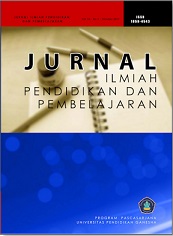PENGGUNAAN MODEL PEMBELAJARAN PROBLEM BASED LEARNING BERBANTU MEDIA KONKRIT DALAM UPAYA PENINGKATAN PROSES DAN HASIL BELAJAR MUATAN IPA TEMA7 SUBTEMA 1 KELAS 4
DOI:
https://doi.org/10.23887/jipp.v2i2.14636Abstrak
ABSTRACT
The research was carried out in order to improve the processes and outcomes of learning with media concrete on the charge on IPA Theme 7 subtema 1. The research was carried out on May 7-May 16, 2018 at 4th grade Student Affairs Tegalrejo 01 school year 2017/2018. This type of research using research action class. The percentage of observations of teachers has increased from 53% to cycle pre 72.5% in cycle I and 85.5% in cycle II. Students experience increased activity of pre cycle 51.67% to 71.66% in cycle I and 86.5% in cycle II. Student learning outcomes on pre cycle amounted to 11 students with a percentage of 40.74%, and not completely 16 students with percentages of 59.26%. After doing a repair on the cycle I increase that is 19 students complete with a percentage of 70.37% and 8 students not finished with a percentage of 29.63%, the result of the repair cycle I have yet to achieve the attainment of indicators i.e. 80% ketuntasan, then in to perform a repair cycle II. After the execution of the cycle II an increase in 23 students finished with a percentage of 85.19% whereas students who do not complete amounted to 14.81 percentage people with 4%. Thus improvements with the Model of Problem Based Learning with concrete media can say successful because the results of learning objectives i.e. the percentage of 80%.
Keyword: Problem Based Learning, Concrete Media, processes and Outcomes of learning, science
Referensi
Airlanda, G. S. 2016. Analisis Kualitas Pendidikan Ditinjau dari Penerapan Kebijakan Sekolah Gratis di SMA Negeri 1 Weru Kabupaten Sukoharjo. Jurnal Pendidikan Sains. 4(1): 43.
Eggen, P., dan Kauchak, D. 2015. Strategi dan Model Pembelajaran Mengajar Konten dan Keterampilan Berpikir. Jakarta: Indeks.
Hosnan, M. 2014. Pendekatan saintifik dan kontekstual dalam pembelajaran abad 21: Kunci sukses implementasi kurikulum 2013. Ghalia Indonesia
Kurniawan, Deni. 2011. Pembelajaran Terpadu Teori, Praktik dan Penelitian. Bandung: Pustaka Cendikia Utama
Mawardi, M. 2014. Pemberlakuan Kurikulum SD/MI Tahun 2013 dan Implikasinya Terhadap Upaya Memperbaiki Proses Pembelajaran Melalui PTK. Scholaria: Jurnal Pendidikan dan Kebudayaan, 4(3): 109.
Mawardi. 2018. Merancang Model dan Media Pembelajaran. Scholaria.1(1): 29.
Prastowo, A. 2014. Pemenuhan Kebutuhan Psikologis Peserta Didik SD/MI Melalui Pembelajaran Tematik-Terpadu. Jurnal Pendidikan Sekolah Dasar. 1(1): 10.
Sari, D. L., Mawardi. 2015. Keefektifan Model Pembelajaran Picture And Picture dan Make a Match Ditinjau dari Hasil Belajar Dalam Pembelajaran IPA Kelas 4 SD Gugus Mawar-Suruh. Scholaria. 5(3): 87.
Sanjaya, Wina. 2009. Strategi Pembelajaran Berorientasi Standar Proses Pendidikan. Jakarta: Kencana Prenada Media Group
Supinah, dan Sutanti, Titik. 2010. Pembelajaran Matematika di SD. Yogyakarta: PPPPTK Matematika.
Susanto, A. (2013). Teori Belajar dan Pembelajaran di Sekolah Dasar. Jakarta: Pernadamedia Group.
Sumarjilah, Y. 2015. Penggunaan Media Kongkrit untuk Meningkatkan Hasil Belajara Matematika Pokok Bahasan Penjumlahan dan Pengurangan Bilangan pada Siswa Kelas 1 SDN Rejoagung 01 Kebupaten Jember. Pancaran. 4(4): 70.
Trianto, M. P. 2010. Model Pembelajaran Terpadu. Jakarta: Bumi Aksara
Tursinawati. 2013. Analisis Kemunculan Sikap Ilmiah Siswa dalam Pelaksanaan Percobaan pada Pembelajaran IPA di SDN Kota Banda Aceh. Jurnal Pionir.1(1): 69.
Widiantono, N., dan Harjono, N. 2017. Penerapan Model Pembelajaran Interaktif untuk Meningkatkan Aktivitas dan Hasil Belajar IPA Siswa Kelas 5 SD. Scholaria. 7(3): 200.
Unduhan
Diterbitkan
Cara Mengutip
Terbitan
Bagian
Lisensi
Authors who publish with the Jurnal Ilmiah Pendidikan dan Pembelajaran (JIPP) agree to the following terms:
- Authors retain copyright and grant the journal the right of first publication with the work simultaneously licensed under a Creative Commons Attribution License (CC BY-SA 4.0) that allows others to share the work with an acknowledgment of the work's authorship and initial publication in this journal.
- Authors are able to enter into separate, additional contractual arrangements for the non-exclusive distribution of the journal's published version of the work (e.g., post it to an institutional repository or publish it in a book), with an acknowledgment of its initial publication in this journal.
- Authors are permitted and encouraged to post their work online (e.g., in institutional repositories or on their website) prior to and during the submission process, as it can lead to productive exchanges, as well as earlier and greater citation of published work. (See The Effect of Open Access)










